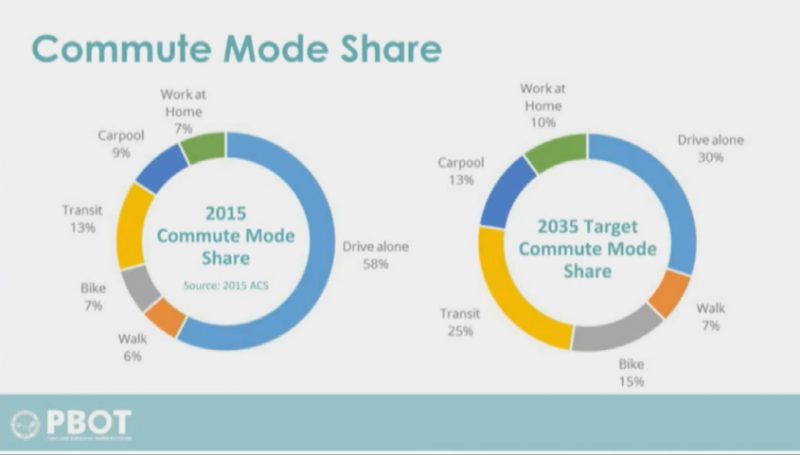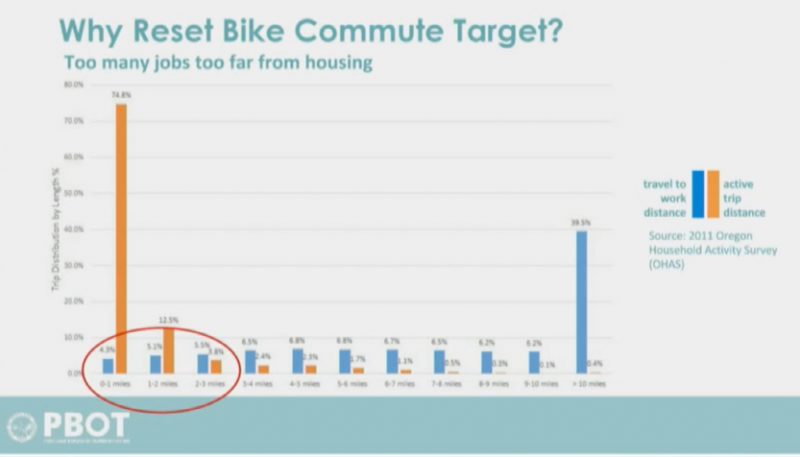
For the past eight years one of the strongest organizing principles for Portland-area bike advocates has been the stated goal of having 25 percent of commute trips made by bike by the year 2030.
Now, in what appears to be a sign of backpedaling, the City of Portland wants to decrease the bike commute mode share target to just 15 percent — a 10 percent reduction.
The change comes as the City redefines several “system performance measures” in stage three of its Transportation System Plan update process.
“Even in 2035 there are too few jobs too far from housing to get as far as we would ideally like to go.”
— Peter Hurley, PBOT
As word about this change leaked to the public, many people were perplexed and concerned. With a current bike commute mode share of 7 percent (according to 2015 U.S. Census figures), it’s no mystery that getting to 25 percent in just 13 years would not be easy; but that’s what goals are for right?
Why are they doing this? We’ve heard several rationales.
Asked for official comment, PBOT Communications Director John Brady said that the source of the 25 percent figure was the Climate Action Plan, whose drafters took the number from the Bike Plan. But, he says, the Bike Plan’s 25 percent number was actually for all trips, not just work commute trips. (According to PBOT, work commutes make up just 12 percent of all trips.)
Brady added both of the targets — commute and all trips — were “aspirational”. “They were not based on an evaluation of whether land-uses, investments, and policies would support those targets.” Now that PBOT has done more analysis of where people live and work, their modeling shows it will be all but impossible to reach 25 percent bike commute mode share by 2035 given current trends.
“When you conduct an analysis of trip distances from home to work, the proposed land uses, aggressive new bicycle facility investments and policies, then it becomes clear that they may support a doubling of bike commute mode share to 15 percent,” Brady says, “but are not sufficient to support a 25 percent bicycle commute mode split by 2035.”
In a presentation on June 13th to the Portland Planning and Sustainability Commission, PBOT Senior Planner Peter Hurley explained what he referred to as a “reset” — not a downgrade — of the bike commute goal. “Based on our charts [of distance from work and likelihood to bike], even in 2035 there are too few jobs too far from housing to get as far as we would ideally like to go [in terms of bike commute mode share],” he said. Hurley added that regional travel demand models also, “Showed unfortunately pretty low bike mode shares in 2035.” (Although he cautioned the current modeling tool isn’t a reliable way to predict mode share.)
Advertisement

When questioned about his confidence in the analysis by Planning Commmissioner Chris Smith, Hurley said the trip distance numbers made it clear to him a decrease was necessary. “I think we can make some progress through the investments in bike network connectivity,” he said, “I think we can actually move the numbers significantly… But when we looked at all the relatively small bike projects and how much they’d contribute… the ones that don’t take a lane or that don’t take any parking… those make major changes in improving bike access; but not necessarily the longer trips.”
“With an aggressive investment strategy and a congestion measure that focuses on moving people, the doubling of bike mode share in the next 20 years is in the realm of possibility,” Hurley added. “But quadrupling it? Unless we have some policies that aren’t currently on the table that’s probably not a possibility.”
For context, the drive alone commute mode share now is about 58 percent and PBOT’s 2035 target is 30 percent. To help reach that goal, the plan is to double biking to work from 7 percent to 15, and increase transit commutes from 13 to 25.
Another component that has influenced the City’s mode share thinking is that for the first time (as per a recommendation from the Planning Commission), the City of Portland is including “Work at home” as a stated goal. They’ve proposed a work at home target of 10 percent.
For PBOT, this shift is in line with their efforts to make performance targets “realistic and achievable” says Brady. “To do that, we link these targets with better data and more rigorous evaluation of the data, including more evaluation of the projected performance of future transportation investments and policy changes.”
PBOT is due to bring the TSP updates back in front of the Planning Commission on September 26th.
Today is the last day to comment on this stage of the TSP update. If you want to share your opinion about this “reset” of the bike commute mode share number, you can email comments to TSP3@portlandoregon.gov.
— Jonathan Maus: (503) 706-8804, @jonathan_maus on Twitter and jonathan@bikeportland.org
BikePortland is supported by the community (that means you!). Please become a subscriber or make a donation today.

